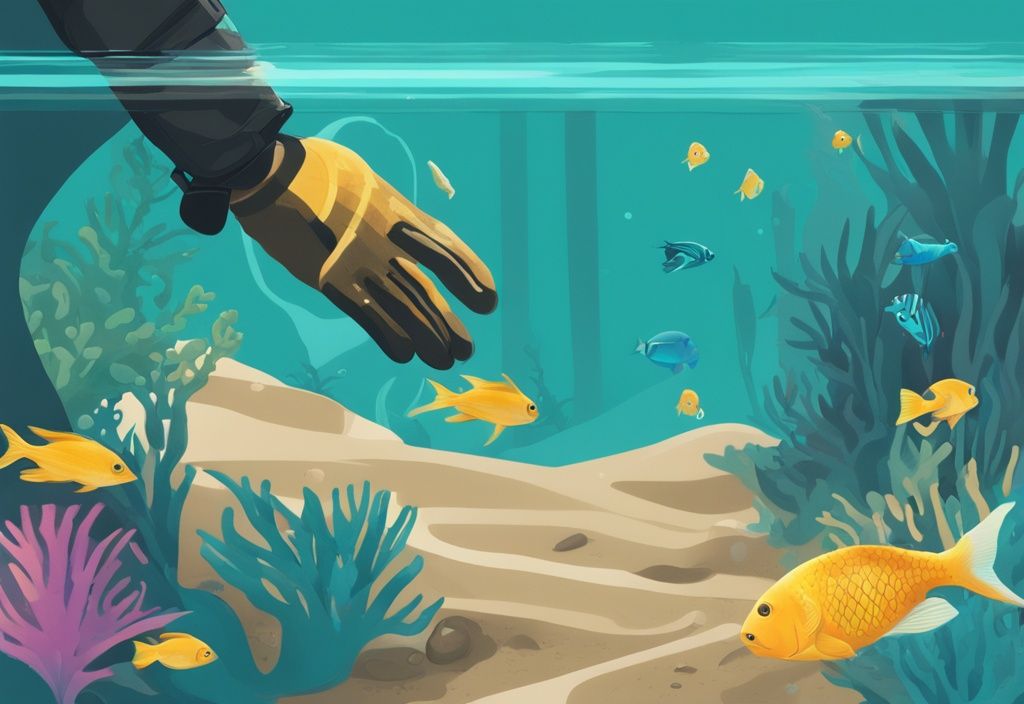Isn’t it disheartening when your once lively and colorful aquarium turns into a murky mess? Let me share something important – it all starts with the sand. Understanding how to clean aquarium sand is paramount for a thriving fish community. I’m Dr. Melanie Rivers, and I’ve spent two decades as a marine biologist unraveling the secrets of aquatic ecosystems.
In this piece, you’re joining me on a journey towards meticulous sand maintenance – a pursuit critical in avoiding toxic spikes, preserving water quality, and creating a stress-free environment for your aquatic pals. Whether your aquarium posits fine or medium-course sand, I’ll equip you with practical and efficient techniques to keep it immaculate.
There’s more! We’ll also delve into nature’s own sand cleaners, offering environmentally friendly solutions tailored for any setup. Together, let’s transform your tank into a vibrant underwater haven!
How to Clean Aquarium Sand
Why You Should Clean Your Aquarium Sand
Cleaning your aquarium sand regularly is crucial for maintaining a healthy and thriving aquatic environment. By removing waste materials, you prevent the decay and buildup of harmful substances, which can otherwise deteriorate water quality. This routine task helps in reducing nitrate levels, ensuring water parameters remain optimal for fish and other inhabitants. Regular cleaning also prevents ammonia spikes, avoiding toxicity that can adversely affect or kill your tank’s residents. Ultimately, keeping the sand clean enhances water clarity, lending a visually appealing aspect to your aquarium and contributing to the overall health and balance of the aquatic ecosystem.
The Benefits of Regularly Cleaning Aquarium Sand
Maintaining clean aquarium sand offers numerous benefits. It helps in reducing nitrate levels, ensuring water parameters remain optimal for fish and other inhabitants. Regular cleaning also prevents ammonia spikes, avoiding toxicity that can adversely affect or kill your tank’s residents. Ultimately, keeping the sand clean enhances water clarity, lending a visually appealing aspect to your aquarium and contributing to the overall health and balance of the aquatic ecosystem.
What Could Happen If You Neglect Sand Maintenance
Neglecting sand maintenance can lead to several detrimental effects. Accumulated waste can degrade water quality and potentially cause disease outbreaks among your fish. The buildup of organic debris often results in an increase in harmful bacteria and algae. Untended sand beds may form toxic anaerobic pockets, releasing dangerous gases such as hydrogen sulfide. Furthermore, the decline in oxygen levels within the sand bed disrupts beneficial bacteria colonies, leading to compromised health and stress for aquatic inhabitants due to poor water conditions.
Preparing Aquarium Sand for Initial Use
Rinsing new aquarium sand is essential to ensure a clear and healthy tank setup. Adding the sand to your tank safely will prevent disturbances and maintain water quality from the start.
How to Rinse and Clean New Sand
Rinsing and cleaning new sand is essential to ensure a clear and healthy tank setup. Start by purchasing high-quality aquarium sand that best fits your tank’s specifications. Place the sand in a large bucket and fill it with water. Vigorously stir the sand to loosen dust and debris, then pour out the cloudy water. Repeat this rinsing process until the water runs nearly clear. Allow the rinsed sand to dry before introducing it to your aquarium; this step helps minimize cloudiness once it’s in the tank.
Adding New Sand to Your Aquarium Safely
To safely add new sand to your aquarium, first submerge a bowl or container filled with the cleaned sand. Gently pour the sand into place, taking care to avoid stirring up the existing substrate. Spread the sand evenly, maintaining a thickness of about 2.5 cm without compacting it excessively. If you are replacing old substrate, add the new sand gradually to avoid disrupting the tank’s balance.
Getting Started with Aquarium Sand Cleaning: Tools and Equipment
Using the right tools makes cleaning your aquarium sand more efficient. Here’s a guide to essential and optional equipment that can simplify the process and improve results.
Essential Tools Required for Cleaning Aquarium Sand
Effective sand cleaning starts with the right tools. A gravel siphon with a wide cylinder is crucial for cleaning sand efficiently. Use a collection bucket to siphon out water and debris without risking an overflow. A net is handy for spot cleaning and removing debris from the surface, while a turkey baster can be used for gentle cleaning in tanks with delicate inhabitants or low bioloads.
Enhancing the Cleaning Process with Optional Tools
To enhance your cleaning routine, consider incorporating a power vacuum to trap loose dirt and return clean water to the tank. Magnet sticks can be useful for sifting through the sand and preventing compaction. Cover vacuum intakes with fine mesh or pantyhose when cleaning tanks that house shrimp or small fish. Additionally, introducing sand-sifting fish and invertebrates like Corydoras or jawfish can naturally help keep the substrate clean.

How the Right Aquarium Sand Makes Cleaning Easier
Your choice of aquarium sand can significantly impact the ease of cleaning. Fine sands, such as Moonlight (0.25-0.75mm), require more frequent cleaning due to suspension issues. Medium-course sands like Crystal River (0.5-1.0mm) are easier to clean and less prone to suspension. Larger grain sands facilitate easier cleaning, akin to gravel cleaning methods. Avoid mixing different substrates, as it complicates the cleaning process and may disrupt the tank’s balance.
Step-by-Step Guide to Routine Aquarium Sand Cleaning
Cleaning your aquarium sand efficiently requires a methodical approach. Below, find detailed steps for using various tools and techniques to maintain a sparkling clean tank.
How to Clean Aquarium Sand Using a Gravel Vacuum
Begin by removing any décor and rocks to access the sand more easily. Connect your siphon to a collection bucket ensuring smooth water flow. Insert the wide end of the siphon into the sand, allowing it to rise partially and loosen debris. Pull the siphon up slightly so that the sand falls back while debris is siphoned out. Clean systematically, covering one width-length of the tank at a time. Monitor the bucket to avoid overflow; you can use the siphoned waste water to rinse filter media.
Cleaning Aquarium Sand with a Power Vacuum: A Detailed Guide
For power vacuum cleaning, assemble the vacuum and immerse it in the tank near the sand bed. Start the vacuum to siphon out dirt and debris while returning clean water to the tank. Move it slowly across the sand surface to avoid deep compaction, focusing on high-traffic waste accumulation areas. Keep the vacuum filter clean to maintain efficiency.
Daily Spot Cleaning to Maintain Aquarium Sand Health
Daily spot cleaning helps maintain sand health by removing visible debris with a net or small siphon. As part of your routine, consider using a turkey baster to dislodge and remove surface detritus. Moreover, monitor and control feeding to prevent overfeeding and excess waste buildup.
Taking Your Cleaning Routine to the Next Level: Advanced Techniques
Elevate your sand cleaning routine with advanced strategies to manage algae growth, prevent compaction, and use innovative tools for deeper cleaning.
Deciphering the Mysteries of Algae Growth on Sand
Understanding algae growth on sand can offer insights into your tank’s health. Recognize that normal algae growth signifies a healthy environment. Manually remove algae from the sand using a siphon or gentle scraping tool. Adjust the tank’s lighting and nutrient levels to control excessive growth. If you’re wondering why your fish tank might be green, introducing algae-eating species can also help manage algae naturally.
Dealing with Compaction and Gas Pockets in Deep Sand Beds
Preventing compaction and gas pockets in deep sand beds involves regular maintenance. Rake through the sand using a stick or similar tool to keep it loose. Periodically perform deep cleanings to release any trapped gases. Employ sand-dwelling species that naturally stir and aerate the substrate. Monitoring water parameters can help detect harmful gas buildup early.
The Advantages of Using Magnet Sticks in Your Sand Cleaning Routine
Magnet sticks are useful tools for aquarium sand cleaning. They assist in sifting through the sand to remove fine debris and prevent compaction efficiently. These tools can reach deeper sand layers, ensuring thorough cleaning and can be combined with other spot cleaning tools for enhanced effectiveness.
Customized Cleaning Approaches for Different Types of Sand
Different types of aquarium sand need tailored cleaning methods to maintain a healthy tank environment. Here’s how to handle fine, medium-course, and using sifting species for natural cleaning.
Cleaning Methods Tailored for Fine Aquarium Sand
Cleaning fine aquarium sand requires a gentler approach to avoid sucking up the particles. Use a gentle siphon technique and rinse fine sand thoroughly before adding it to your tank to reduce cloudiness. Combine careful manual cleaning with frequent water changes to maintain tank health.

How to Clean Medium-Course Sand in Your Aquarium
Medium-course sand is less likely to be sucked up during cleaning, making the process simpler. Hover the gravel vacuum slightly above the sand to loosen and remove debris. Combine regular deep cleaning with spot cleaning to ensure the health of the sand bed.
Utilizing Sifting Fish and Invertebrates for Natural Sand Cleaning
Incorporating sand-sifting fish and invertebrates like Corydoras, Suckermouth catfish, and specific shrimp can naturally maintain sand cleanliness. Ensure these species receive adequate nutrition to supplement their sifting activities. Monitor and adjust their numbers based on the tank size and sand conditions.
Expert Tips and Tricks for Keeping Your Aquarium Sand Spotless
Keeping your aquarium sand spotless involves strategic food waste control, advanced cleaning methods, balanced maintenance, and optimizing water circulation.
Food Waste Control: A Key to Cleaner Sand
Control food waste by feeding your fish in measured amounts to prevent decaying remnants within the sand. Promptly remove any uneaten food to avoid buildup. Establishing a feeding schedule tailored to your tank’s needs and inhabitants can help maintain cleanliness.
Advanced Deep-Sand Cleaning Strategies to Try Out
To prevent anaerobic pocket formation, regularly stir the sand bed. Consider partial sand bed replacement during water changes for a more thorough clean. Employ advanced cleaning tools, like power vacuums, for deeper and more efficient cleaning.
Striking the Balance: Avoiding Over-Cleaning while Preserving Beneficial Bacteria
When cleaning, avoid completely turning over the sand bed to preserve beneficial bacteria colonies. Leave certain areas undisturbed to foster bacteria growth. Regular water parameter testing can help monitor and maintain biological balance within the tank.
Optimizing Water Circulation for Healthier Sand
Ensure even water flow throughout the tank to evenly distribute waste materials and prevent debris from settling and compacting. Utilize aquarium equipment like powerheads to boost circulation and maintain a healthier sand environment.
Conclusion
Cleaning aquarium sand involves several essential steps and considerations that play a crucial role in maintaining a healthy tank environment.
Adhering to consistent maintenance routines, employing proper cleaning techniques, and selecting the right type of sand are all fundamental. Imagine your aquarium as a captivating underwater landscape; regular upkeep is like the gardener’s touch ensuring its vibrancy.
It’s vital to remove waste materials regularly, as this prevents decay and the buildup of harmful substances. This proactive approach not only curbs potential health hazards but also reduces nitrate and ammonia levels, creating a thriving habitat for your aquatic friends. To gain a deeper understanding of maintaining water quality in your freshwater aquarium, you can learn more here.
Ensuring water clarity is another critical factor. Clean sand enhances the visual appeal of your aquarium, transforming it into a pristine environment that’s a joy to observe. Plus, this cleanliness supports beneficial bacterial colonies, which are the unsung heroes in maintaining the ecosystem’s balance.
Ignoring sand maintenance can lead to severe issues, including poor water quality, harmful bacteria and algae proliferation, and toxic anaerobic pockets. Addressing these concerns proactively promotes the well-being of your fish and ensures the longevity of your aquarium setup.

Consistent cleaning efforts, whether through spot cleaning or periodic deep cleaning, make a significant difference. Tools such as gravel vacuums, power vacuums, and even natural cleaners like sand-sifting fish and invertebrates are invaluable. Tailoring your approach based on the sand type—whether fine, medium-course, or larger grain—also simplifies maintenance.
Ultimately, employing these suggestions and techniques on how to clean aquarium sand will lead to a thriving and visually appealing home for your aquatic inhabitants. Keeping these pointers in mind ensures your aquarium remains a healthy, balanced, and stunning focal point in your space.
Frequently Asked Questions (FAQs)
How often should I clean my aquarium sand?
Routine spot cleaning can be done daily, while deep cleaning is recommended monthly for maintaining water clarity and the health of the inhabitants. Daily spot cleaning helps you keep on top of any waste or uneaten food, preventing them from settling into the sand and decomposing. For deep cleaning, gently siphon the sand with a gravel vacuum designed for aquariums, ensuring you remove built-up debris without disturbing beneficial bacteria.
Can a regular vacuum cleaner do the job of cleaning my aquarium sand?
No, a regular vacuum cleaner is not suitable for this delicate task. A gravel vacuum specifically designed for aquariums is essential to safeguard the tank environment and its inhabitants while effectively cleaning the sand. Using the right tool allows you to clean without disrupting the ecosystem you’ve worked hard to maintain.
What are the tell-tale signs that my aquarium sand needs cleaning?
Visible debris on the sand surface, unpleasant odors, and poor water clarity are clear indicators that your aquarium sand requires cleaning. When you start noticing these signals, it’s time to take action to prevent any adverse effects on your aquatic pets and the overall tank environment.
How can I prevent my aquarium sand from compacting?
Prevention is key when it comes to compacting sand. Regularly raking through the sand with a stick or spatula helps keep it aerated. Additionally, introducing sand-sifting species like certain types of snails or fish can naturally aerate the sand, ensuring a healthy substrate. This not only prevents compacting but also promotes a dynamic and engaging environment for your aquarium’s inhabitants.
Is different substrate mixing safe for my aquarium?
Mixing substrates might sound like a good idea, but it can complicate the cleaning process and potentially disrupt the tank’s balance. Different substrates have varied weights and compositions, which could hinder your cleaning efforts and affect the overall health of your aquarium. For optimal maintenance, it’s best to choose one type of substrate.
What to do when sand clogs up my aquarium filter?
First, ensure your sand is well-rinsed before placing it in the aquarium. This minimizes the chances of fine particles clogging your filter. Adjust your cleaning techniques, such as siphoning gently to avoid stirring up the sand too much. Additionally, using mesh covers on filter intakes can prevent the sand from getting sucked into the system, ensuring smooth operation and clean, clear water.
